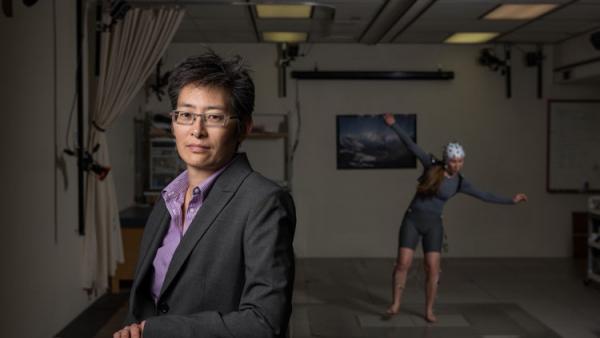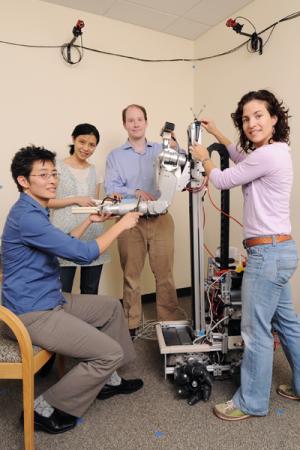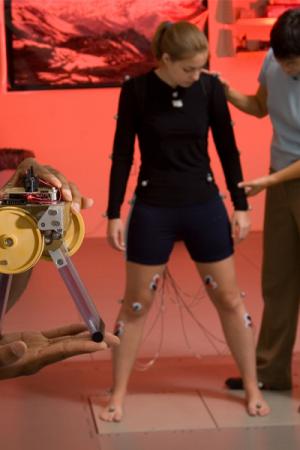Lena Ting is in the liminal space between computation and neurophysiology, illumining how the brain works with the nervous and musculoskeletal systems to move the body. In this interview she explains how her diverse training experiences allow her to make waves in a new discipline, as director of the Neuromechanics Lab at Emory University, and to bring together researchers from different scientific backgrounds to study movement disorders. She also offers advice for embracing nonlinear thinking and charting your own path.
This article is part of Neuronline’s interview series “Entrepreneurial Women Combining Neuroscience, Engineering, and Tech,” which highlights the career paths and scientific accomplishments of female leaders and role models who are creatively bridging disciplines to improve lives.
What sparked your interest in mechanical engineering, and how did you decide to apply your training to neuroscience?
I’d always loved biology but did not like how it was taught, so I decided to go into a quantitative science. In the mechanical engineering program at Berkeley, I discovered I was interested in robotics and felt like we could design and control machines to understand how animals move.
I looked at labs that were using biology and engineering, and I actually worked in a neuroscience lab, looking at human movement control, but I found my love of science in a lab studying insect walking biomechanics. It occurred to me that I needed to know what the neurons tell the body to do, so I went to graduate school at Stanford to do simulations of movement from a biomechanical perspective.
Until then, I never thought I’d be a neuroscientist. It was so complicated, and I’d gone in to do computation, after all. After doing experiments, though, I decided I would like to go into neuroscience, and I did two postdocs — one in Paris in spinal cord electrophysiology, and the other a behavioral neurophysiology postdoc in Oregon.
Throughout my training, I walked around the problem of locomotion, looking at many different fields and how they contribute to our understanding of how we move. In my lab now, we integrate all those different methods.
How would you describe your work?
In all of my work, my perspective is: What is that fundamental, scientific understanding we're missing that would enable us to better understand movement disorders?
I'm most well-known for muscle synergies or motor modules, which is the idea that we can observe the habitual patterns of muscle activity used to construct movements. I think of it as a library of biomechanical actions, and when I perform a new action, it’s based on that library of actions. We all have similar ones, but mine are unique to me.
For example, we’ve shown that dancers might have slightly different habitual patterns of movement that allow them to achieve a broader repertoire of movements. When they learn to do challenging tasks, they're refining the motor modules they use in walking, so it also changes the way they walk. Instead of having to develop a whole new pattern, you're sculpting your habitual one so that it can do more.
The reason we're interested in it actually has to do with rehabilitation. My colleague Madeleine Hackney has people with Parkinson's dance an adapted tango that affects how they walk every day.
You’ve taken inspiration from electrophysiology, neurophysiology, how dancers move, and the world around you, connecting many seemingly unrelated things. How did you develop this type of creative thinking?
My way of thinking naturally tends to be more integrative and holistic — trying to look at how a principle integrates across different fields and how it might apply to patient populations. I’ve noticed other women in science think similarly.
In graduate school, however, you’re trained to follow the literature, which can be very linear.
Some of the arguments I saw in the literature seemed very one-or-the-other, and I thought, "They both make sense, and maybe they would work together." I felt I wasn’t a good scientist because I didn’t understand why these ideas were at odds with each other.
That hurt my confidence as a grad student, and I think it's the reason I felt like each field I went to wasn't quite right. I was moving from humans to animals to computation, trying to find my place. It wasn't until I got my own lab when I was able to put it all together and make it work.
How did you learn to use your way of thinking to your advantage?
It was a challenge. In the meritocracy of science, that can be seen as lacking focus.
A lot of times, linear thinking causes hyper-specialization of fields. When you start integrating ideas across areas, then you have to get yourself into fields you may not be the world expert in. That can be very uncomfortable, and it makes it easy for people not to place stock in your ideas.
So in mostly male-driven fields, if a woman comes in, she may be taken to sound like she doesn't know what she's talking about. I felt that, but I also felt the onus was on me to become confident enough in that field that I could explain myself.
How did you become more confident owning your work and sharing its impact?
It was scary at first. I didn't know if I would get a faculty position. It's a doubt a lot of people have, especially women. I needed encouragement to apply because I wasn't sure I was ready.
When my dream job opened, I knew if I didn't at least try, I would regret it. That really served as a catalyst for me to ask myself, “What am I scared of?” and, “If I could have that dream job, wasn't it worth putting myself out there?”
Then, early in my assistant professor years, my postdoctoral mentor “made” me run a workshop at a conference. I was scared, but it was an extremely important experience. I had to speak to other colleagues whom, honestly, I was intimidated by, but the panel was really well-received, and I started to feel like I could be part of this community.
Since then I’ve realized people have different ways of thinking, and it doesn't mean they're smarter than or not as smart as me. People come to the table with different experiences, training, and ideas. Finding a way to communicate them is important for science, and it’s important to me. I found my place as a translator between different areas, bridging the differences in assumptions and ways of thinking across fields.
As we work with roboticists and neurologists, I’ve continued to try to understand the lens by which different fields and people see the world and show them connections where they don't think they exist. My lab’s culture reflects that.
If we approach each other as equals, rather than from a place of thinking one field is better than another, it goes a lot farther toward having a fruitful collaboration.
What advice do you have for other women considering a similar career?
The advice I give to anyone looking to take the next step in their training is to think about what do you want to do in another field, and then challenge yourself to go beyond that and immerse yourself in that other field, so that the field that you create is in the in-between.
If you’re a nonlinear thinker, it can take much longer to find what you're looking for. I see that a lot with people who are more of a creative, scattered type like me. When I was kid I always wondered how people could know the one thing they wanted to spend all of their time doing. I felt like I had to know early on what it was that I wanted to do forever. I didn't find that until after I’d gone through undergrad, grad school, two postdocs, and a faculty position, and honestly, it keeps changing. I now know that's okay. That's my way of discovering the world.
About Lena Ting, Ph.D.
Lena Ting is codirector of the Georgia Tech and Emory Neural Engineering Centers and the John and Jan Portman Professor of Biomedical Engineering at Emory and Georgia Tech, and a professor in the Department of Rehabilitation Medicine, Division of Physical Therapy at Emory University. She is director of the Neuromechanics Lab, which draws from neuroscience, biomechanics, rehabilitation, robotics, and physiology to study how movement intention translates to action. Focusing on complex, whole body human movements such as bipedal walking and standing balance, which have strong clinical relevance, as well as skilled movements seen in dancers and athletes, she uses computational and experimental methods to understand both normal and impaired movement control. She has discovered principles of human movement and, in collaboration with physical therapy researchers, is developing novel interventions for Parkinson’s disease, stroke, and spinal cord injury.
This article was originally published on NEURONLINE, March 9, 2020, by the Society for Neuroscience.
Media Contact
Walter Rich
Keywords
Latest BME News
Jo honored for his impact on science and mentorship
The department rises to the top in biomedical engineering programs for undergraduate education.
Commercialization program in Coulter BME announces project teams who will receive support to get their research to market.
Courses in the Wallace H. Coulter Department of Biomedical Engineering are being reformatted to incorporate AI and machine learning so students are prepared for a data-driven biotech sector.
Influenced by her mother's journey in engineering, Sriya Surapaneni hopes to inspire other young women in the field.
Coulter BME Professor Earns Tenure, Eyes Future of Innovation in Health and Medicine
The grant will fund the development of cutting-edge technology that could detect colorectal cancer through a simple breath test
The surgical support device landed Coulter BME its 4th consecutive win for the College of Engineering competition.










